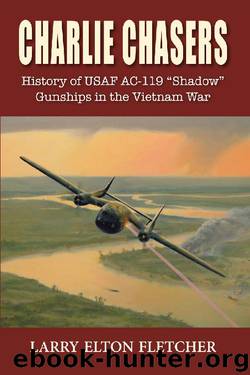Charlie Chasers by Larry Elton Fletcher

Author:Larry Elton Fletcher [Fletcher, Larry Elton]
Language: eng
Format: epub
Publisher: Hellgate Press
Published: 2013-06-15T04:00:00+00:00
ELEVEN
Guardian Strikers
Seventh Air Force Aerial Interdiction Campaigns to interrupt the flow of NVA troops and supplies down the Ho Chi Minh Trail from North Vietnam through southern Laos and eastern Cambodia started during the northeast monsoon dry season of 1968-69 with the operation code name “Commando Hunt.” Commando Hunt I began 15 November 1968 and ended in April 1969. Each of the following six campaigns lasted approximately six months during each wet and dry monsoon season.
Seventh Air Force designated the southwest monsoon (wet) season Commando Hunt II and subsequently designated even-numbered Commando Hunt Campaigns IV and VI for the rainy southwest monsoon season and designated odd-numbered Campaigns III, V, and VII for the northeast monsoon dry season. The last Commando Hunt VII ended in April 1972.
The interdiction campaigns had two major objectives: 1) To reduce the enemy’s logistical flow by substantially increasing the time needed to move supplies from North Vietnam to South Vietnam and 2) To destroy trucks and supply caches along the roads, pathways, and waterways and in enemy truck parks and storage areas along the trail.
Air Commando propeller-driven AT-28, A-26, A-1E aircraft and fighter/bomber jets like the F-4, F-100, and F-105 were used against truck traffic on the Trail during the time period of Hunt I thru Hunt III. It soon became evident that risking a multi-million dollar jet aircraft to destroy one truck was ludicrous. In addition to requiring a FAC to mark targets, fighter jets flying at speeds exceeding 200 knots proved to be much less accurate than slower propeller-driven attack planes in hitting small targets like a truck.
Propeller-driven AC-47 gunships flying low and slow in firing orbits over the Trail proved effective but increased losses of the aircraft to enemy anti-aircraft fire proved that the Spooky gunship was too vulnerable for anti-aircraft guns located in Laos. In early 1969, AC-119G Shadow gunships of the 71st SOS also flew missions on the Trail, but were soon relieved of that duty because of vulnerability to enemy anti-aircraft guns. Armed with latest sensor technology and the firepower to orbit at higher altitudes, aerial interdiction success of AC-130 and AC-119K fixed-wing gunships opened command level jet-focused eyes to see that the Spectre and Stinger gunships were much more effective on the Trail, and thus became the dominant aerial interdiction attack force in the war against the Ho Chi Minh Trail.
As Commando Hunt operations proved successful, North Vietnam responded by placing larger numbers of anti-aircraft artillery (AAA) weapons (e.g., 23mm, 37mm, and 57mm guns) along the Ho Chi Minh Trail in Laos. By 1970, enemy triple-A sites on the Trail had increased to a point wherein the sites became targets for U.S. fighter/bombers to attack, while protecting USAF Spectre and Stinger gunships working the Trail.
After Cambodia Prince Sihanouk was ousted from power in March 1970, the Lon Nol government closed the country’s major seaport at Sihanoukville and renamed it Kompong Som. The so-called “Sihanouk Trail” from the seaport overland route through Cambodia to supply arms and ammunition to NVA/VC sanctuaries located on the eastern border with South Vietnam no longer existed.
Download
This site does not store any files on its server. We only index and link to content provided by other sites. Please contact the content providers to delete copyright contents if any and email us, we'll remove relevant links or contents immediately.
| Africa | Americas |
| Arctic & Antarctica | Asia |
| Australia & Oceania | Europe |
| Middle East | Russia |
| United States | World |
| Ancient Civilizations | Military |
| Historical Study & Educational Resources |
1-Bound by Honor(782)
The Saigon Sisters by Patricia D. Norland(673)
A Piece of My Heart by Keith Walker(558)
What We Inherit by Jessica Pearce Rotondi(555)
Into Cambodia by Keith Nolan(544)
Abandoning Vietnam by James H. Willbanks(539)
The United States, Southeast Asia, and Historical Memory by Pavlick Mark;(539)
The March of Folly by Barbara W. Tuchman(537)
Where the Domino Fell by James S. Olson & Randy Roberts(537)
Gunship Pilot by Robert F. Hartley(532)
12, 20 & 5 by John Parrish(528)
We Were Soldiers Once...and Young by Harold G. Moore;Joseph L. Galloway(525)
They Were Soldiers by Joseph L. Galloway(518)
Charlie Company's Journey Home by Andrew Wiest(513)
A Time for War: The United States and Vietnam, 1941-1975 by Robert D. Schulzinger(499)
Green Beret in Vietnam by Gordon Rottman(492)
Rethinking Camelot: Jfk, the Vietnam War, and U.S. Political Culture by Noam Chomsky(491)
Carrier: A Guided Tour of an Aircraft Carrier by Tom Clancy(486)
America At War - Concise Histories Of U.S. Military Conflicts From Lexington To Afghanistan by Terence T. Finn(455)
